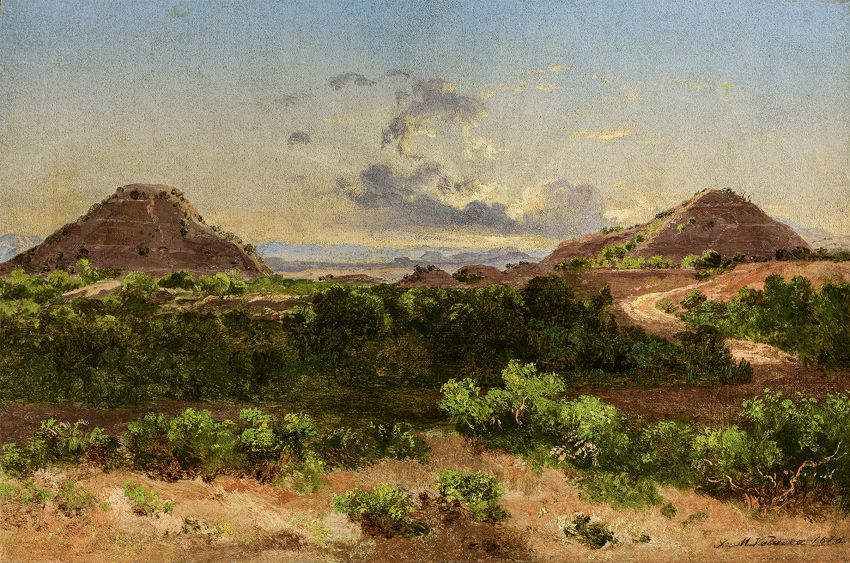One of the most important artists of Mexico, “Jose Maria Valasco: A View of Mexico” is now on display at the National Gallery of London until August 17. For the first time, the gallery dedicated a Latin American artist to a Latin American artist, referring to 200 years of diplomatic relations between Mexico and the United Kingdom.
The National Gallery, located in Trafalkar Square, London, is one of the world’s most visited museums. It has 2,300 Western European paintings in the early 20th century from the Middle Ages. Unlike many European museums, the national gallery is not established in a state collection; Instead, in 1824, the British government started buying 38 paintings from a private banker. From the very beginning, its purpose is clear: these paintings belong to the public. Admission is always free.
The images created by Jose Maria Valasco are deeply tied to the national identity of Mexico. His landscapes are well -known, and he is a household name across the country. Yet Velasco’s art is rarely seen in Europe. There is no Valasco painting in the UK General Collection, not a great international exhibition dedicated to the painter since 1976. This London Showing Box provides a rare and long -term opportunity to enjoy his works to global audience.
A painter who defined a nation
Born in 1840, Jose Maria studied under the Italian painter Eugenio Landesio at Academia de San Carlos in Mexico. Despite being trained in the European tradition, Valasco quickly created his unique style and became Mexico’s most famous natural artist. Valasco is a real polymoid: a man with deep intelligence and vast curious man, followed by studies in the fields that enriched his art, including anatomy, geology, botany, antique and the history of Meso American. Valasco approached the art from a scientific point of view, not only to capture the beauty but also to analyze the world around him. His paintings reflect deep reverence for nature and the awareness of its weakness during the era of rapid industrialization.
When Jose Maria Walasco began her life, the Mexican painting was often focused on human figure. Nature, if added, was often a backdrop. By dedicating most of his works to the landscapes, Valasco put the natural world in the center of his art. His paintings are stunning and technically have a unique visual structure: layer perspectives, accurate compounds and the compliance of color and the compliance and proportions of color, and promoting the prosperity of the natural world.
Combining the eye of a scientist and the soul of an artist, Valasco has created nearly 300 works, including paintings, watercolors, lithography and miniature. These became valuable educational equipment and brought him national and international recognition. In 1881, he was appointed as a testament to his position in both the Mexican Society of Natural History, a rare honor and artistic and scientific communities.

Of his best works, the “Mexico Valley” paintings and the wide views of the Mexico Valley have been painted in many versions for years. These great terrain offers a scene about the surrounding area of Mexico before being replaced by urban development. One version was gifted to Pope Leo XIII, now owned by the Vatican Museums.
Valasco in the National Gallery
The exhibition contains 30 works from public and private collections, of which 17 are from the Museum D Art in Mexico. There are three paintings from the National Museum in Prague. These belong to the unique pharmacist of Emperor Maxilian I, Frandisek Gaza. During the short -term regime of Maximium in MexicoCaska appointed the appointed work directly from Valasco. After the Emperor’s execution in 1867, Kasa continued to play a diplomatic role, and secretly rescued the relations between Austria and Mexico.
Among the highlights of the exhibition, “Bopocattel and Istakshwatl” from Salko Lake, in 1885, paid tribute to the disappearance of Lake Lake. Valasco puts the audience at the water level and painted the eye upwards to two snow -covered volcanoes.
The exhibition has over 50 years of career life and has been organized as six theme categories, each reflects the wide range of interests of Valasco and how they designed his art. The “terrain and professional” section of the “terrain and industry” sees the “terrain and professional” section of the 1800s in the late 1800s, with paintings such as “La Carolina, Puebla’s textile plant”. The section “Flora” focuses on his love for plant life, “an oldest bridge in San Angel” and “Garden, Oksaka State”. At the center of the exhibition, “Santa Isabel is from the Mount Mexico Valley”, is often considered the greatest work of Valasco. Other categories include “ruins and archaeological,” “geographical time” and “delayed works”, including his last known painting and “study”.

The work of Valasco helped to define the nation’s visual identity. In 1943, the Mexican government announced a national historical monument to recognize its prolonged cultural value. The exhibition gives foreign visitors a rare opportunity to explore the prosperity of his work, from volcanic peaks to ancient ruins, giant aloe and uprooted industrial views. For those who come to the National Gallery, this is an opportunity to see Mexico through the eyes of Valasco.
Sandra Kans Kahan San is a Mexican writer and translator, a base -based site, and he is a specialist in mental health and humanitarian aid. She believes in the power of language to promote compassion and understanding in cultures. Can access her (Email protected)








